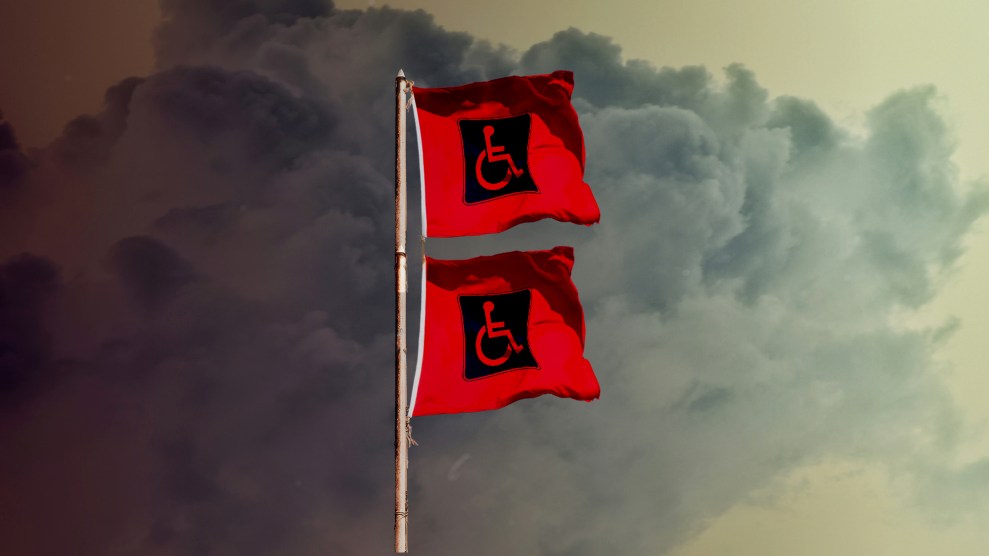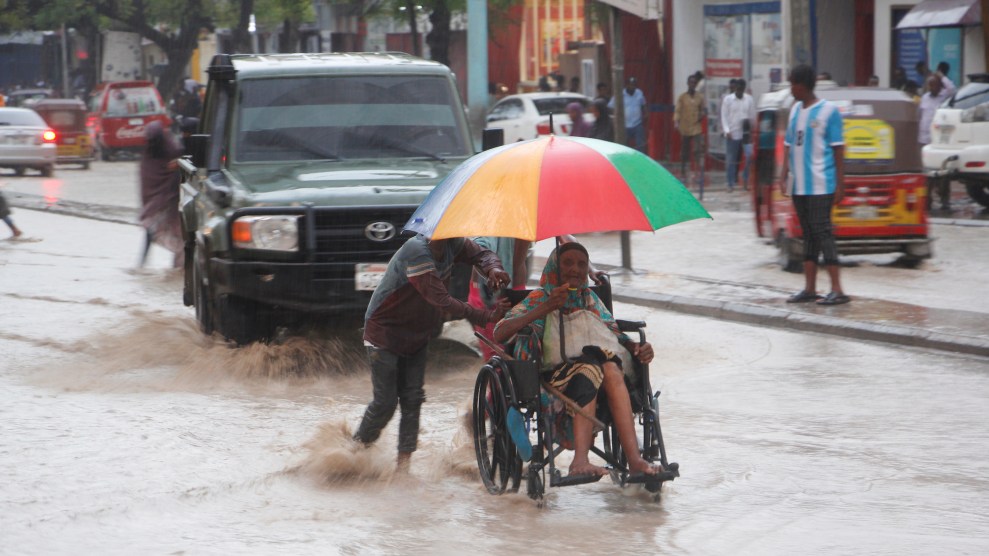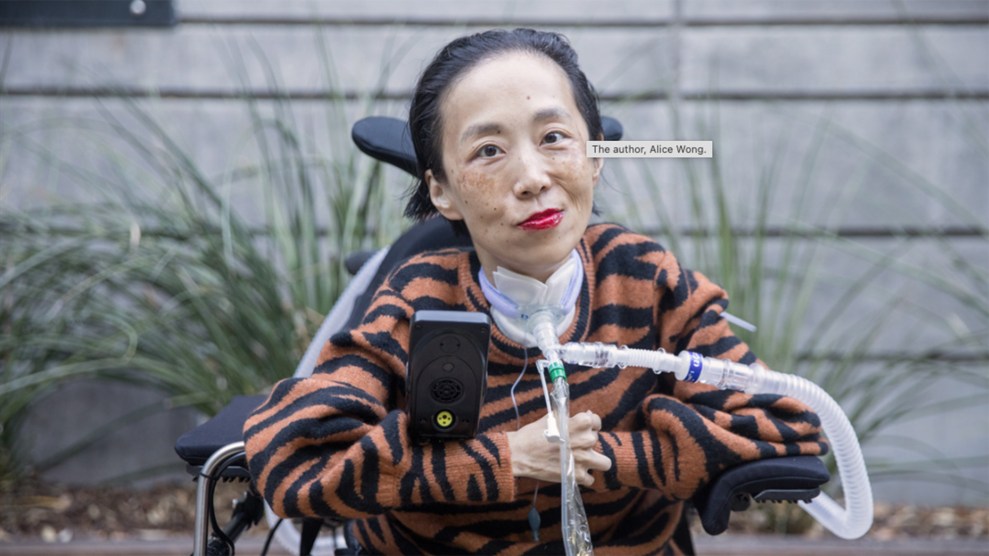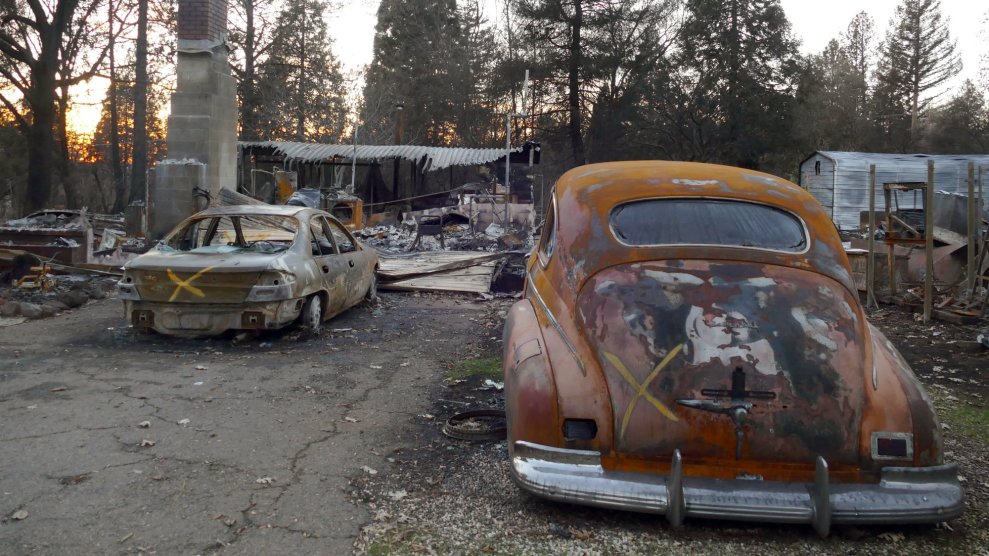
Mother Jones; Getty; Preillumination Seth
During the 1960s, disability activists fought for the right to live independently, rather than in institutions like nursing homes. That led to the first Center for Independent Living: a hub serving and largely run by people with disabilities, established in Berkeley, California, in 1972—now one of 403 locations across the country. CILs help disabled people live at home who might otherwise have been institutionalized, in part by connecting them with resources like state programs to fund home care.
Now, in the worsening climate crisis, CILs have a new challenge: helping disabled people prepare for and survive extreme weather events, which are becoming both more severe and more frequent. The difficulties they face drive home the disproportionate and often ignored impact of climate change on people with disabilities. Extreme heat, for instance, puts disabled people in particular at increased risk of dying. Losing power can ruin essential medication that needs cold storage. And when it comes to local evacuation plans for wildfires and flooding, mobility issues are often unaccounted for. The list could go on and on.
Disabled people are “two to four times more likely to die or be injured in [climate] disasters or crises than nondisabled people.”
Hundreds of disabled people in the San Francisco Bay Area died as a consequence of power outages between 2005 and 2012, notes Berkeley’s CIL emergency preparedness and outreach coordinator Henry Maeko—a systematic failure that’s put pressure on the region’s natural gas and electricity company, PG&E.
“Because of the harm done to disabled people during power outages and heat waves,” Maeko says, PG&E “has been essentially mandated to provide funds for disability centers and communities in order to provide things like backup batteries.”
Back-up batteries and generators can be the difference between life and death for people on respirators. Severe temperatures, either hot or cold, can also cause people to experience life-threatening complications. Even in a blue state like California, people with disabilities died in extreme weather before more assistance was provided to CILs in 2020.
But in red states, it’s even more of an uphill battle to secure lifesaving funding and resources for disabled people amid the climate crisis. A Buzzfeed News analysis estimated that more than 700 people died after Texas’ power grid failed during winter storms in 2021. Experts expect these preventable deaths to continue until Texas politicians allow changes to the power grid—which seems very unlikely, given the GOP’s strong hold on the state legislature.
Before the independent living movement, many disabled people were regularly pushed into locked residential facilities, psychiatric hospitals and other institutions, even from a young age. Through CILs, they can receive one-on-one, in-person assistance, remote classes, and social services while retaining their autonomy (the right for disabled people to live outside institutions didn’t come until a 1999 Supreme Court ruling).
“We got frustrated with traditional agencies, people without disabilities, telling people with disabilities how to live, without that disabled experience,” says Theo Braddy, the executive director of the National Council on Independent Living.
That autonomy can be a matter of life or death. More than once, institutions like nursing homes, prisons, and hospitals have abandoned people in floods and fires, or ignored them in heat waves, with fatal results.
Michael Stein, the executive director of the Harvard Law School Project on Disability, said that federal laws like the Americans with Disabilities Act make it a legal issue, not just a moral one, when disabled people are “discriminated against or excluded from federal, state and other programming” like disaster plans.
That includes local governments and organizations like the Red Cross, which still need to have emergency plans that account for the needs of disabled people, said Shaylin Sluzalis and Germán Parodi, the co-executive directors of the Partnership for Inclusive Disaster Strategies.
Disabled people are “two to four times more likely to die or be injured in [climate] disasters or crises than nondisabled people,” Sluzalis said, “largely due to the inaccessible society that we live in.”
“Finding out two days later that a hurricane struck does no good to people with disabilities.”
One issue that arises, according to Stein, is inaccessible information —such as news about climate events on sites that don’t work with a screen reader. “Receiving the same information at the same time is one of the requirements of disability law,” Stein said. “Finding out two days later that a hurricane struck does no good to people with disabilities.”
Inaccessible climate plans are also an international problem. Although the 2015 Paris Agreement on limiting emissions required “inclusive responses to climate mitigation,” Stein says, almost nine in ten countries that signed “don’t even mention disability in their policies.”
Experts I spoke to agree that disabled people need to be welcomed and heard in climate-related plans. As Braddy notes, when they’re not, “everything is based on the able-bodied experience,” sometimes fatally.
The United States, like many other countries, is ill-prepared for extreme weather in general. The Partnership for Inclusive Disaster Strategies maintains a hotline to address that gap by connecting as many disabled people to resources as quickly as possible—especially to their local CIL.
“One of our main ways of really supporting disabled disaster survivors is connecting them with their local Center for Independent Living,” Sluzalis said. “We do a soft handoff of those referrals, so folks don’t continue to fall through the gaps of calling one place and then calling the next.”
The partnership’s directors themselves went to Puerto Rico after Hurricane Maria, which devastated the island in 2017, to try and help disabled disaster survivors. One in three adults in Puerto Rico is disabled, according to the CDC, highlighting the importance of inclusive disaster response in the territory. One of the groups the partnership collaborated with—in addition to FEMA, the Red Cross and local government—is MAVI, a nonprofit which operates two independent living centers in Puerto Rico.
Back in the Bay Area, Berkeley’s CIL is also helping people prepare for serious earthquakes, including by offering to earthquake-proof their homes. While California has always been known for its earthquakes, research suggests that they will become more common with climate change. Maeko says the center provides both group training and “one-on-one workshops, where we’ll sit with an individual person or a family, we’ll talk through what they might need in emergency preparedness, and we base it on specific needs. We’ll talk about what it would look like for you to be independent during an emergency.”
Braddy believes that governments and agencies collaborating with CILs, both in planning for and during climate events, can help save disabled people’s lives. That includes training Red Cross staffers on how to safely evacuate someone’s wheelchair or ventilator, which are indispensable extensions of a person.
“When emergency-prepared people come into a local community, they don’t know where these individuals live,” Braddy said. “They don’t know the kind of complex medical equipment that these individuals depend on.”
But a local CIL will know just that, Braddy said—something he’s talked to FEMA about. In climate catastrophes, Braddy said, CILs “should be an integral part of that rescue and that management.”














